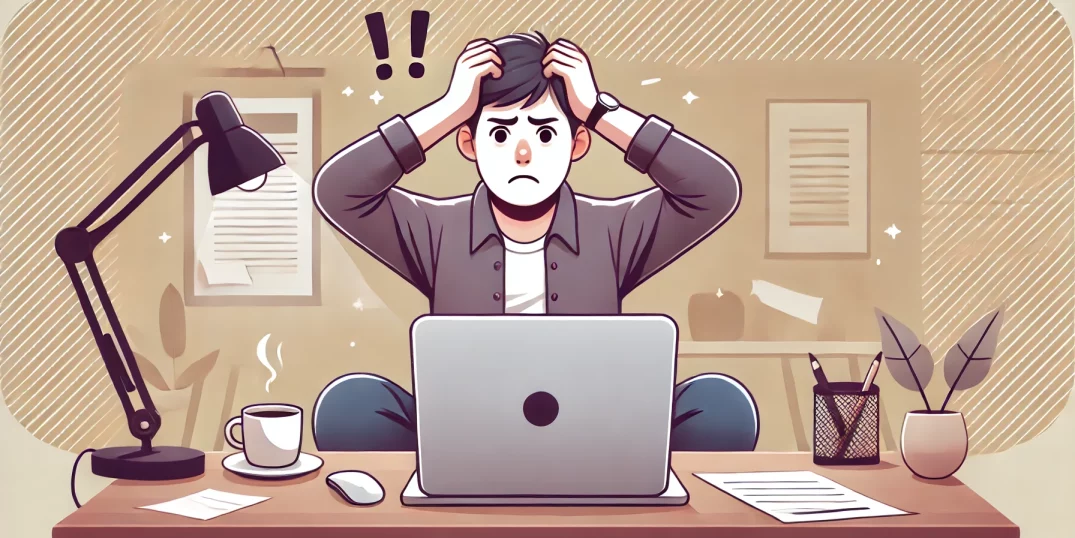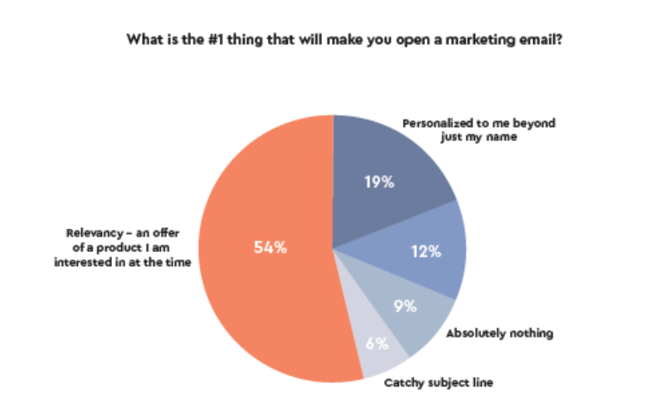- Home
- Fundamentals of Email Marketing
- How to Overcome Email Marketin ...

I love reading: diving into history, exploring the latest in AI, and getting lost in the worlds of art and design. But what I don’t care about? Cooking tutorials, pet news, and computer games. And I made sure my reading app knew that by carefully picking my interests and filtering out everything irrelevant. Yet, every week, my inbox was flooded with a random assortment of articles—a recipe for the perfect soufflé followed by a deep dive into ancient civilizations.
While there were great articles here and there, it felt less and less like a personalized reading experience and more like casting a fishing net into an ocean of content. After months of frustration, I gave up trying to find something interesting for me in the pile of irrelevant news. Moreover, I noticed that I no longer looked forward to reading at all. The thought of impending depression crossed my mind.
The moment I switched to a different app, one that actually understood my preferences, my reading desires came back. That’s when I realized—it was never about depression; it was email fatigue in action—the overwhelming flood of irrelevant content that turned my initial engagement into exhaustion.
So, what is email fatigue, actually? How relevant is it nowadays? And how many people wish it never happened to them? Let’s explore!
What Is Email Marketing Fatigue?
Email marketing fatigue refers to the phenomenon where subscribers become disengaged, overwhelmed, or frustrated with the frequency and volume of marketing emails they receive. This often leads to lower open rates, declining engagement, higher unsubscribe rates, and even spam complaints.
Why Is Email Marketing Fatigue a Growing Challenge?
The number of emails sent and received daily is growing from year to year. In 2026, this number is predicted to hit 392.5 billion! That is truly mind-boggling. So, it is no wonder that customers are becoming more selective about what they open and engage with. Simply put, there are just too many emails to bother checking each and every one. In fact, mailing customers too often is one of the main reasons they opt to unsubscribe. Several factors contribute to the rise of email fatigue:
- Email overload—Consumers receive dozens, if not hundreds, of emails each week, making it harder for any single message to stand out.
- Repetitive or irrelevant content—When brands send too many emails without personalization or real value, subscribers start simply ignoring them.
- Increased competition—With more businesses using email marketing, the battle for attention in the inbox is now fiercer than it ever was.
- Changing consumer expectations—Modern audiences expect highly relevant, timely, and engaging content. If your emails don’t live up to these standards, they are ignored.
Causes of Email Marketing Fatigue
Excessive email frequency
When brands send emails too often, subscribers can feel bombarded rather than engaged. Even if the content is relevant, an overwhelming volume of messages is just too much to process for an average human. So, instead of figuring out what’s worth reading and what’s not, messages are ignored altogether.
Poorly timed emails
Timing plays a crucial role in email engagement. If emails arrive at inconvenient hours—such as too early, too late, or during email-heavy seasons—users will most likely ignore them. Similarly, sending too many emails close together can exhaust subscribers, making even well-crafted messages lose their impact.
Lack of personalization and segmentation
This one is huge! Modern subscribers expect brands to recognize their preferences, behaviors, and purchase history. When emails feel generic, they become less engaging. Sending the same message to every subscriber without considering demographics, past interactions, or browsing habits makes emails feel impersonal and, thus, forgettable. Next time—they are not opened at all.
Overuse of promotional language
Constantly pushing discounts, urgency-driven CTAs, or aggressive sales tactics can wear out even the most engaged subscribers. If every email feels like a high-pressure situation, it creates a sense of fatigue rather than excitement. People want value and variety in their inbox, and they also want to know that no one pushes them towards their choices.
Complicated unsubscribe process
Willing to unsubscribe is customers’ right. When subscribers want to opt out but find it too tricky, it creates frustration. Instead of going through a complicated process, some may simply mark emails as spam. And can you blame them for it? Another potential drawback: with a difficult unsubscribe process, people will be less likely to return in the future.
Lack of value in emails
If emails don’t provide useful, engaging, or exclusive content, they become easy to ignore. Today subscribers want insights, inspiration, or offers that make them feel valued. When emails focus only on the brand’s needs rather than the subscriber’s interests, they get treated accordingly: simply overlooked.

Signs That Your Audience Is Experiencing Email Marketing Fatigue
The loss of interest and engagement does not happen overnight—it is a gradual process. For a while, your subscribers are eagerly opening your emails, clicking through, maybe even making a purchase. And then, gradually, they start ignoring them. The open rates drop. Click-throughs shrink. Unsubscribes rise. Before you know it, your emails are met with silence. If you wonder what happened, the answer is: most likely it is marketing fatigue. More specifically, email fatigue. The good news is: most likely consumers are overwhelmed not just by your brand but by dozens of others. When there are too many emails altogether, your emails, no matter how well-crafted, start feeling like another annoying ding! in your inbox. That’s how consumer fatigue sets in.
Which warning signs to look for?
If you’ve been watching your metrics and seeing a slow but steady decline, it’s time to take a closer look. Open rates used to be strong, but now, fewer and fewer people even glance at your subject lines. Click-throughs plummeted, which means even those who still open your emails aren’t interested enough to engage. And then there are the unsubscribes, which might be the biggest red flag of them all. When people start actively removing themselves from your list, it means they are not just tired but want to break up with your brand altogether.
Even when subscribers do open your emails, they still might be disengaged. They skim. They scroll. They close. Some might even mark your messages as spam—not necessarily because you’ve done anything wrong, but because in a moment of inbox frustration, they just want fewer emails, and yours happened to be in their way. These are all signs of email fatigue. This is also the point when your email campaigns are no longer just ineffective—they’re actively damaging your sender reputation.
If you come to this point, it is time to take a step back and look at the patterns. Ask yourself these questions:
- Have you increased your send frequency?
- Have your messages started feeling repetitive?
- Are you truly providing value, or are you just showing up out of habit?
If you answered yes to some or all of those questions, that might be an explanation of your users’ behavior. It is frustrating, but it is not hopeless, and below we will discuss ways of combatting email fatigue and even preventing it.
Strategies to Combat Email Marketing Fatigue
When email fatigue starts creeping in, it’s not enough to just hope for the best while doing the same thing. Start by trying different approaches: testing new subject lines, experimenting with different content formats, and analyzing the data. In the end, email marketing isn’t set in stone. Below are some strategies that are worth considering when email fatigue starts to take a toll on your performance and audience engagement.
Let subscribers breathe
If your open rates are dropping and unsubscribes are climbing, it might be time to reassess the frequency of your emails. Too many emails sent too often accelerate consumer fatigue (even when content is great). Instead, let subscribers choose how often they hear from you—weekly, biweekly, or just for major updates. By giving them more space and freedom to regulate the frequency, you might be surprised that your open rates suddenly grow again.
Prioritize relevance over routine
If every email sounds the same—another sale, another “hurry before it’s gone” message—people stop paying attention. Instead of sending for the sake of sending, focus on delivering content that actually matters. What have they clicked on before? What topics resonate best with them? Remember that behavior-based emails triggered by user actions always outperform generic content.
Segment like you mean it
Not all subscribers are the same, so why treat them that way? Someone who just joined your list doesn’t need the same message as a loyal customer. Someone who only buys in December won’t care about your July clearance sale. The more you segment—by behavior, purchase history, or engagement levels—the more relevant your emails become. And relevance is the antidote to marketing fatigue.
Make unsubscribing easy (Yes, really)
It might sound counterintuitive, but if someone wants to leave, let them. A complicated unsubscribe process doesn’t keep people engaged—it makes them frustrated. Worse, it increases the chances they’ll mark your emails as spam, and you don’t want that! A simple, clear unsubscribe option (with the alternative to adjust email frequency) keeps your list clean and ensures that those who stay are genuinely interested.
To Sum Up
As we figured out, fighting email fatigue isn’t about tricking subscribers into staying but about giving them a reason to want to stay. And that starts with respect: for their time, their inbox, and their preferences. Because when you get it right, your emails stop being just another message in the pile. They become those rare ones that people actually look forward to.



